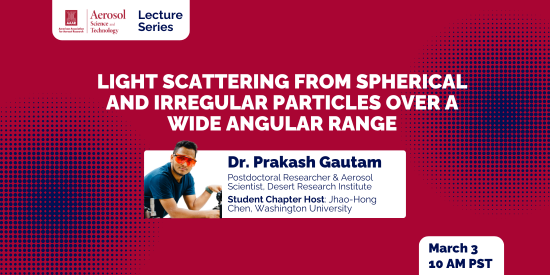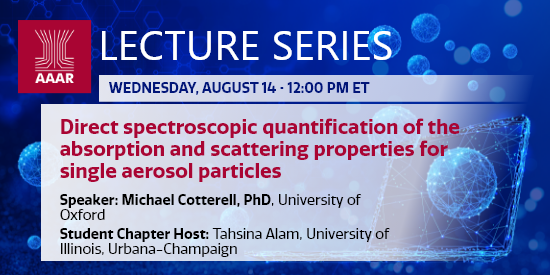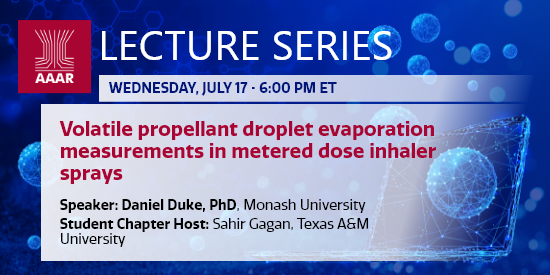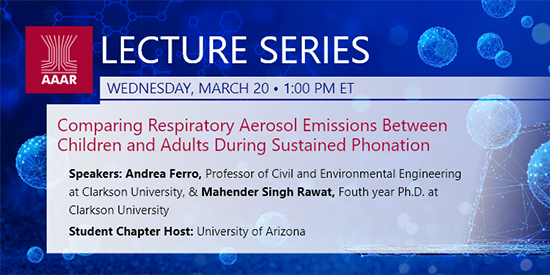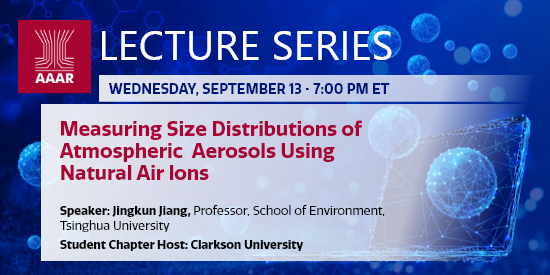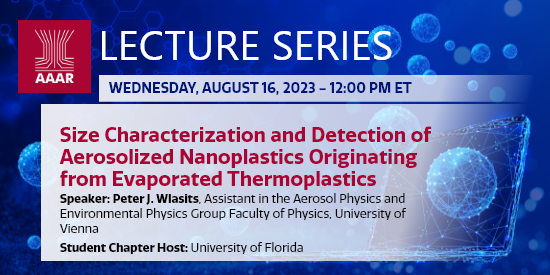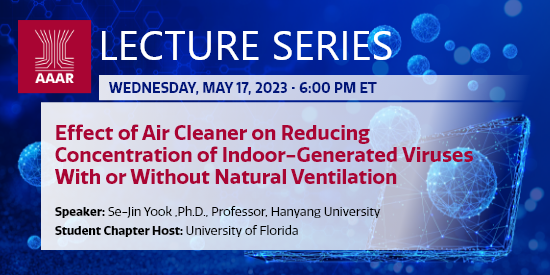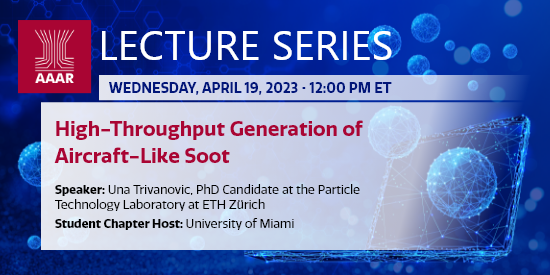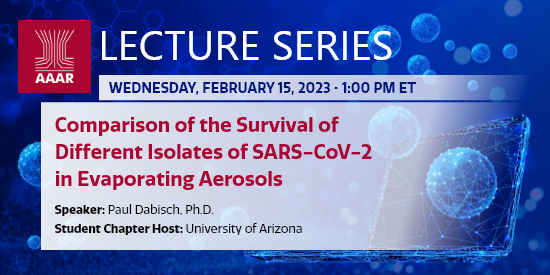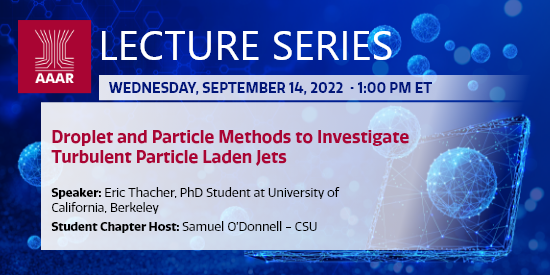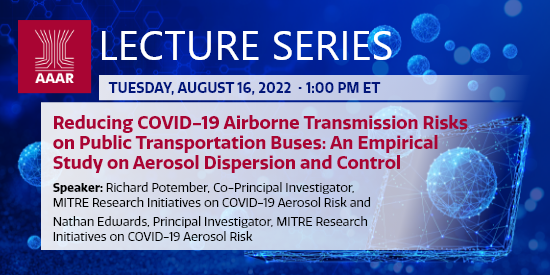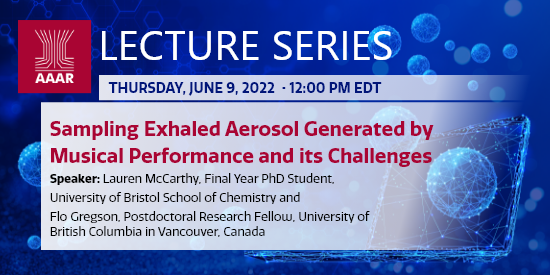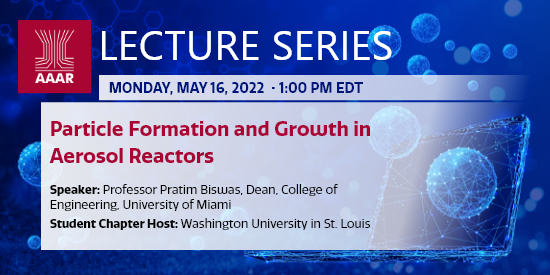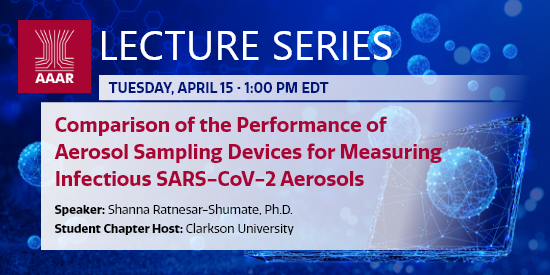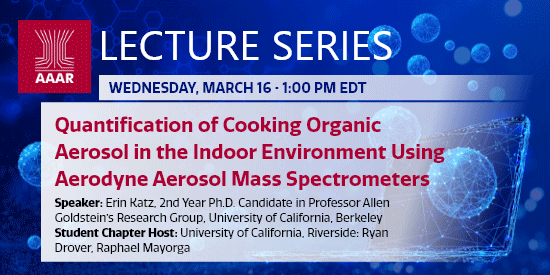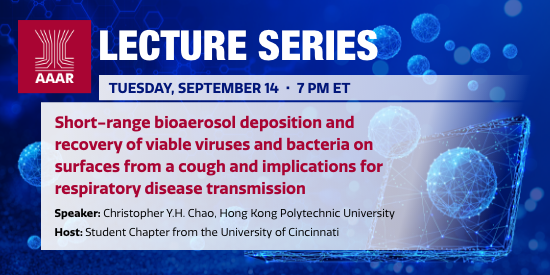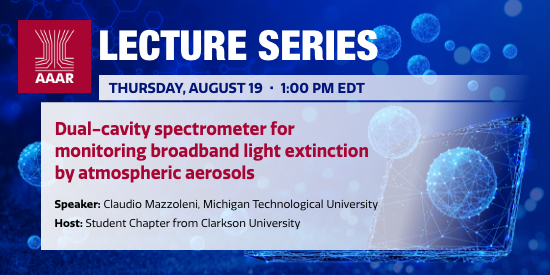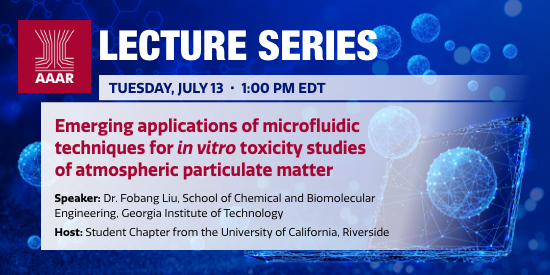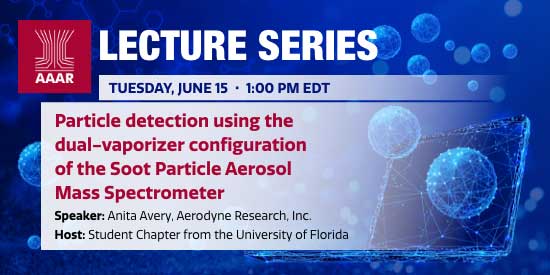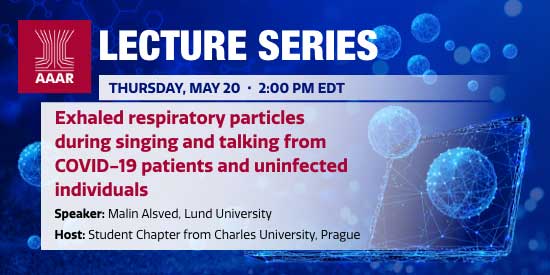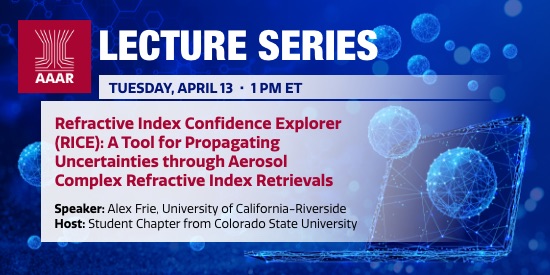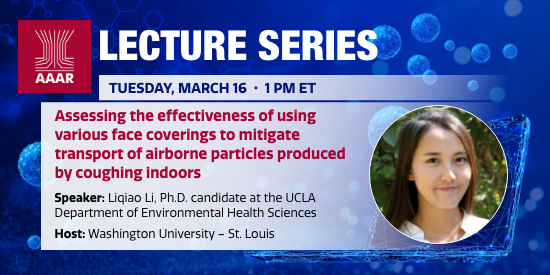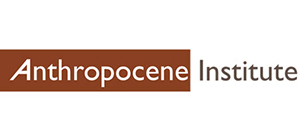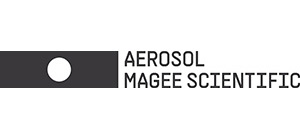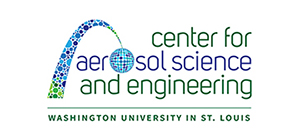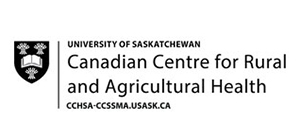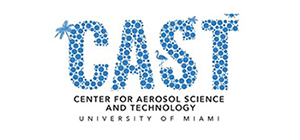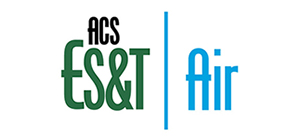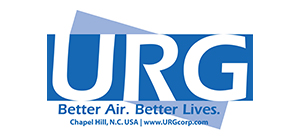AAAR AS&T Lectures
This new initiative, supported by the Sheldon K. Friedlander Memorial Fund, will feature a high-impact paper selected by the Editors of AS&T to be presented by its author live, webinar-style, monthly. Each lecture is free and open to all.
With this new program being launched by the Endowment Committee, AS&T Editorial Office, and Early Career Committee, AAAR aims to highlight the research in our community, tie our Journal to other AAAR activities, and provide an opportunity to bring our membership together outside of the Annual Conference. One way we're achieving this is by engaging with AAAR's Student Chapters from across the nation to serve as hosts. A different Student Chapter will be the host each month and will take part in a Journal Club of their design, where they meet ahead of each Lecture to discuss the paper to be presented.
Upcoming Lectures

-
Abstract:
This presentation first briefly summarizes the advantages and disadvantages of optical methods for real-time bioaerosol detection, then focuses on measuring the phase functions of differential circular polarization scattering (CIDS) from single individual flowing through or optical-trapped particles, mainly the realizations of the measurement technologies, the primary laboratory results, and theoretical simulations. The results gives encouraging promises in fast distinguishing bioaerosol from non-bioaerosol particles via CIDS measurements, and demonstrates a new technology for developing low-weight, low-cost, low-power consuming real-time biosensor.
-
Speaker Information:
Dr. Yongle Pan is a research physicist at DEVCOM Army Research Laboratory (ARL) since 2009. He is also an elected ARL Fellow, who is one of the most eminent scientists or engineers in ARL. He owns a PhD from East China Normal University in 1993. His research has focused on inventing/developing sensor systems for real-time, in-situ bio- and chem-aerosol detection, mainly based on single particle fluorescence spectroscopy, two-dimensional angular optical scattering, and Raman spectroscopy. He published over 150 refereed journal papers & 3 book chapters, was awarded 11 US patents, had over 5000 citations from other researchers. He has successfully completed more than 20 research projects as a principal investigator (PI) or Co-PI.
Previous Lectures
-
Abstract:
Scattering of light from spherical particles has been explored for more than a century and is well-documented. In contrast, a complete understanding of light scattering by irregularly shaped particles has yet to be achieved. Given that most atmospheric aerosol particles are irregular, their light scattering and absorption significantly impact the radiative forcing in climate models. Many optical models have been developed and are available to calculate the optical properties of irregular particles using spheroid, ellipsoid, and super-spheroidal shapes as surrogate. Still, these surrogates need underlying assumptions and are quite different from the shapes of actual particles. Thus, computational characterization of irregular particles remains challenging, physical insight into the scattering mechanisms is lacking, and a complete comprehensive description encompassing realistic shapes has yet to be obtained. In this context, experimental work capable of measuring the full angular scattering range is crucial for understanding the optical properties of irregular particles.
Here, I will present angularly resolved light scattering data, experimentally measured for particles with diverse microphysical properties, along with the analysis techniques used to provide a comprehensive explanation of light scattering. The methods for interpreting wide-angle light scattering include a) Q-space analysis, plotting the scattered intensity, I, versus the scattering wave vector magnitude, q = 2k sin(?/2), where k = 2?/? and ? is the wavelength, using a log-log scale, and b) Theta-space analysis, plotting I against the linear scattering angle, ?. Furthermore, I will discuss how integrating both methods leads to a more comprehensive understanding of light scattering over all scattering angles.
-
Speaker Information:
Dr. Gautam is a postdoctoral research associate at the Desert Research Institute (DRI) and completed his PhD at Kansas State University. Dr. Gautam is engaged in research combining experimental and theoretical aspects of electromagnetic and light scattering, particularly in atmospheric, climate, and aerosol physics. His work involves designing and developing a multi-angle light scattering setup for real-time, in situ characterization of the optical properties of aerosol particles such as mineral dust, ice crystals, pollen, and bioaerosols. These optical properties include phase function, extinction (scattering + absorption), asymmetry parameter, single scattering albedo (SSA), lidar ratio (LR) , linear depolarization ratio (LDR), and other scattering matrix elements. His recent research has been particularly focused on the development of several key instruments and concepts: 1) a cost-effective sensor for monitoring ambient particulate matter using near-forward scattering, 2) a polar nephelometer capable of measuring light scattering from an extreme forward scattering angle to near exact backscattering angle, 3) theoretical and experimental analysis of the sensitivity of key backscattering phenomena in relation to particle properties such as size, shape, and complex refractive index, 4) the optical properties of soot in various stages of aging, including soot coated with sulfate and other organic materials; and 5) optimizing current aerosol measurement technologies, such as integrating nephelometers by incorporating novel optical schemes..
-
Abstract:
Distinguishing highly viscous (solid) organic particles, such as environmental nanoplastics, within complex atmospheric aerosol mixtures and accurately describing their composition, size distributions, and mixing states are key challenges in aerosol measurement science and technology. This seminar will present results from complementary single-particle measurement techniques used for in-depth characterization of highly viscous particles. We will showcase the advantages and synergy of a multi-modal particle characterization approach, focusing on individual viscous particles from air-discharged waste produced by a common sewer pipe rehabilitation technology. Using oil immersion flow microscopy, we analyze particle size distributions and morphology of colloidal components in field-collected aqueous waste condensates, comparing these with viscous particles formed in drying droplets of the aerosolized waste. Colloidal components and viscous particles were approximately 10 µm and 0.5 µm, respectively. The aerosolized viscous particles exhibited a spherical morphology, while colloidal particles appeared fractal, resembling fragments of cured composite material. Chemical imaging of the viscous particles was performed using scanning electron microscopy and soft X-ray spectro-microscopy, providing a comprehensive description of their high solid-like viscosity, varied sizes, diverse carbon speciation with high oxygenation, and high organic volume fractions. High-throughput single particle mass spectrometry further characterized the aerosolized viscous particles, offering real-time measurements of composition, size, and morphology for large numbers of individual particles, and enabling the identification of their distinct mass spectrometric signatures.
-
Speaker Information:
Dr Alexander Laskin is a Professor of Chemistry at Purdue University. He completed his undergraduate degree in Physics at the Polytechnical Institute, St. Petersburg, Russia, in 1991, and earned his PhD in Physical Chemistry from the Hebrew University of Jerusalem, Israel, in 1998. Following postdoctoral appointments, he served as a staff scientist at the Pacific Northwest National Laboratory (PNNL) from 2001 to 2017. His research interests span the physical and analytical chemistry of aerosols, their environmental and atmospheric impacts, the molecular-level analysis of complex environmental mixtures and chemical imaging of individual particles. His work has produced over 250 publications, including lead and contributing authorship on peer reviewed papers, invited reviews, and book chapters. These contributions have significantly advanced our understanding of aerosols and their wide-ranging environmental impacts.
-
Abstract:
The talk will begin with a general description of AI/ML and how it can assist in advancing aerosol science and technology, primarily from aspects of education. The focus will be on approaches to solve aerosol dynamic models accurately to obtain the size distribution function, that is conventionally often computationally expensive. Conventional artificial neural network (ANN) models offer an alternative procedure to solve the aerosol dynamic equations. However, conventional ANN models can result in violation of aerosol mass conservation. To further enhance accuracy and reduce computational time, a hybrid ANN approach to solve the aerosol coagulation equation is developed, validated, and demonstrated. The methodology and assumptions for the development of the hybrid ANN model which provides an analytical closed form solution for aerosol coagulation is described. The ANN model is trained and validated using a dataset from an accurate sectional model. Following this, the hybrid ANN aerosol model is used to describe the evolution of aerosol in a furnace aerosol reactor. The hybrid ANN model results are compared to the accurate sectional and moment coagulation models. The hybrid ANN coagulation model prediction was found to accurately describe the evolution of the size distribution at a computational cost which is slightly more than the moment model but orders of magnitude less than the sectional model.
-
Speaker Information:
Professor Biswas is the Dean, College of Engineering at the University of Miami. He is a faculty member in the Dept of Chemical, Environmental and Materials Engineering, with an affiliated appointment in the Rosenstiel School of Marine and Atmospheric Sciences. Prior to joining the University of Miami, he was the Lucy and Stanley Lopata Professor and Chair of the Department of Energy, Environmental and Chemical Engineering, and Asst. Vice Chancellor for International Programs at Washington University in St. Louis. Pratim Biswas received his PhD from the California Institute of Technology; MS from the University of California, Los Angeles, and his BTech degree from the Indian Institute of Technology, Bombay.
He directs the world-renowned Aerosol and Air Quality Research Laboratory (AAQRL). He has graduated and advised 65 PhD students, and with them published more than 475 refereed journal articles. For his exemplary contributions in the fundamentals of aerosol science and engineering, Pratim was elected to the National Academy of Engineering in 2019. He has won several other research and teaching awards. He is a Fellow of the AAAS, AAAR, AEESP, IARA and other organizations. He has two start-ups created in the area of aerosol science and technology, and nanoparticle technology.
-
Description:
Single particle cavity ring-down spectroscopy (CRDS) allows direct and continuous measurements of the extinction cross-sections for levitated micron-scale aerosol particles of constant or evolving composition. Our recent interests have concerned single particle CRDS measurements for light-absorbing particles. These measurements are made on single, spherical particles that are evolving in particle size while levitated using an optical or electrodynamic trap. Concurrently, the size of the levitated particles is quantified using elastic light scattering. This talk will summarise the important optical and physicochemical properties of aerosol particles that govern how they interact with light, discuss various methods for levitating aerosol particles, and the factors the affect the accuracy and precision with which optical properties may be assessed using our measurement platform. The limitations of the technique, and potential application in answering key questions in aerosol science, will be discussed.
-
Speaker Information:
Michael Cotterell completed his MSci degree in Chemical Physics (2012) and Ph.D. in Physical Chemistry (2016) at the University of Bristol. After postdoctoral research with Prof Jim Haywood (2016-2019) at the University of Exeter and the UK Met Office, he started his own group as a NERC Independent Research Fellow at the University of Bristol (2019-2023). Since September 2023, Michael joined the Department of Chemistry at the University of Oxford as an Associate Professor. His research is focussed on the development of new approaches to the optical spectroscopy of aerosol particles and the use of these measurements to develop better models of aerosol microphysics and chemistry.
-
Description:
Metered dose inhalers (MDIs) have been used to deliver drugs to the lungs for over 60 years. MDIs rely on the flash-evaporation of a volatile propellant to create a fine aerosol. Since many classes of drugs are insoluble in the propellant, a co-solvent such as ethanol is often used. Predicting the evaporation of binary propellant-ethanol droplets is important in the development of new device designs and therapies. The need for improved measurements and predictive droplet models is highlighted by the need to rapidly transition away from hydrofluorocarbon propellants to low global warming potential propellants, which behave differently. In this study we develop a novel synchrotron X-ray scattering based method of measuring the composition of MDI droplets. When combined with droplet evaporation models, the data reveal the importance of internal diffusion-limiting processes in predicting binary droplet evaporation.
-
Speaker Information:
Dr Daniel Duke is a Senior Lecturer in the Department of Mechanical & Aerospace Engineering at Monash University, Australia. He holds a Bachelor of Engineering and Aerospace Technology (2008) and a PhD in Engineering from Monash University (2013).
Dr. Duke’s area of expertise is the fluid mechanics of aerosols and sprays, with a particular focus on pressurised metered dose inhalers. In his former role as a postdoctoral fellow at Argonne National Laboratory (USA) he developed of a range of novel synchrotron X-ray measurement approaches for cavitation and sprays. Dr. Duke’s current research interests span both experimental and simulation-based approaches to complex multi-phase, multi-component fluid flows.
Dr. Duke has published over 40 peer reviewed journal articles and over 50 refereed conference proceedings in the past decade. He leads the Multiphase flow research group in the Department of Mechanical & Aerospace Engineering at Monash University, supervising several PhD students and postdoctoral research fellows. Dr. Duke is a Fulbright fellow (2011), and an Australian Research Council DECRA Fellow (2017). He has been awarded over AUD 2.5M in competitive research grant funding, and is lead principal investigator on three active ARC projects in the field of cavitation and pharmaceutical sprays.
-
Description:
This talk will present results from the paper by Baboomian et al. (2023) “Light absorption and scattering properties of indole secondary organic aerosol prepared under various oxidant and relative humidity conditions” published in AS&T, as well as new unpublished results on the mechanism of indole oxidation by nitrate radial. The key points of the presentation are: (a) the major product of oxidation of indole by nitrate radical is identified as 3-nitroindole, unambiguously confirmed with reference standards; (b) quantum mechanical calculations suggest that the reaction proceeds by an unusual mechanism, starting from an abstraction of a hydrogen atom from nitrogen rather than carbon in indole; (c) the absorption coefficients for the indole?+?NO3 aerosol particles have a strong and non-monotonic dependence on relative humidity, suggesting two competing reaction mechanisms for the chromophores, and highlighting the complex effect of water on the absorption coefficient of SOA from heterocyclic aromatic precursors.
-
Speaker Information:
Sergey Nizkorodov was born in 1971 in Almaty, Kazakhstan. He received his undergraduate degree in biochemistry from Novosibirsk State University, Russia, in 1993 and graduate degree in physical chemistry from Basel University, Switzerland, in 1997. After doing his postdoctoral research in chemical kinetics and reaction dynamics at the University of Colorado at Boulder, and in atmospheric chemistry at the California Institute of Technology, he joined the faculty of the Department of Chemistry, University of California, Irvine (UCI) in 2002. He teaches general, analytical, and atmospheric chemistry courses at UCI, and does research on chemistry of particulate matter in the ambient atmosphere and in indoor environments using state-of-the-art spectroscopic and mass-spectrometric techniques. He has been a research mentor to over 100 graduate, undergraduate, high-school, and postdoctoral students. His research, education, service and public outreach work have been recognized by several awards including Fulbright Scholarship, AAAS Fellowship, Camille Dreyfus Teacher-Scholar Award, AGU Ascent Award, Coblentz Award, UCI Chancellor's Award for Excellence in Fostering Undergraduate Research, Daniel G. Aldrich, Jr. Distinguished University Service Award, and UCI Professor of the Year Award. He served as the President of the American Association for Aerosol Research (AAAR) in 2020-21, a professional organization of about 1000 scientists and engineers working to advance the field of aerosol research and technology, and been active in various service roles at UCI and in the research community.
-
Description:
The direct effect of aerosols on the Earth's radiative balance remains subject to considerable uncertainties, largely attributed to limited knowledge of fundamental properties of ambient aerosols. The presented study utilizes Monte Carlo uncertainty propagation to evaluate the uncertainty of aerosol scattering coefficients derived from measured particle size distributions. We consider intrinsic uncertainties of the instruments and variabilities in aerosol microphysical properties, such as particle shape, density, and complex refractive index.
-
Speaker Information:
Hagen Telg is a research scientist at NOAA’s Global Monitoring Laboratory and CIRES at the University of Colorado, Boulder, CO. He obtained his PhD in solid-state physics from the Technical University of Berlin (Germany) and embarked on his US journey as a postdoctoral fellow at Los Alamos National Laboratory in 2010. Transitioning to atmospheric sciences in 2013, Hagen initially focused on aerosols from the perspective of instrument development. Later, he increasingly shifted his attention to data product development and analysis of long-term data records, while maintaining his dedication to aerosols.
-
Description:
In this study, we recruited 50 healthy participants from three different age categories and investigated the effect of age progression on the particle emission rate by controlling for vocal intensity and frequency. Despite large interpersonal variability, a relationship between age and emission rate was evident. Mean emission rates for adults were ? 3 times more than those for the children ages 12 ? 18 years and ? 5 times more than those for the children ages 6 ? 11 years. There were multiple statistical outliers, called superemitters, identified in all three age groups.
-
Speaker Information:
Andrea Ferro is a professor of Civil and Environmental Engineering at Clarkson University, the Clarkson Institute for a Sustainable Environment Associate Director for Research, a faculty affiliate of the Clarkson Center for Air and Aquatic Resources Engineering and Science (CAARES), and a fellow of AAAR. Her technical expertise is focused on indoor air quality and human exposure to aerosols. She has been conducting research in the field of particle resuspension for more than 20 years, including measurement and modeling of particle adhesion, detachment and transport at multiple scales, as well as the quantification of human exposure to resuspended particles for various exposure scenarios. More recently, she has conducted studies to characterize respiratory aerosol emissions and various factors that affect these emissions. She has also worked directly with communities, schools, and hospitals to measure, understand, and mitigate sources of aerosol exposure.
Mahender Singh Rawat, currently in his fourth year of pursuing a Ph.D. at Clarkson University, specializes in characterizing respiratory aerosol emissions and investigating the factors influencing these emissions. Additionally, he has conducted research on quantifying virus resuspension from human activity, reflecting his dedication to understanding indoor airborne particle exposure. Alongside his academic pursuits, Mahender actively engages in leadership positions within the graduate student association. With four research articles and a book chapter already under his belt, he demonstrates a strong commitment to advancing knowledge in his field. Beyond academia, Mahender finds solace and joy in nature photography, skiing, hiking, fishing, and kayaking.
-
Description:
Electrical mobility size spectrometers are widely used to measure ambient aerosol number size distributions. A key component of these spectrometers is the neutralizer, which is used to place a stationary charge distribution on the aerosols. Yet, there are natural air ions in the atmosphere which are constantly conditioning atmospheric aerosols. We demonstrate that this natural charging process can be utilized by these spectrometers to measure size distributions of atmospheric aerosols without using a conventional neutralizer. This is achieved by measuring charged particles of both polarities, in contrast to only one polarity as conventionally done. Field measurements in urban Beijing and other sites will be presented.
-
Speaker Information:
Jingkun Jiang is a professor at School of Environment, Tsinghua University. He received a BS and a MS in Environmental Science and Engineering from Tsinghua University. He holds a PhD degree in Energy, Environmental and Chemical Engineering from Washington University in St. Louis. Prior to joining Tsinghua in 2010, he served as a Postdoctoral Research Associate in the Particle Technology Laboratory of Mechanical Engineering Department, University of Minnesota. Dr. Jiang’s research activities involve various topics in aerosol science and technology: aerosol instrumentation; atmospheric new particle formation; PM formation and emissions from combustion activities. He has published more than 200 peer-reviewed journal articles. He received a number of awards including 2018 Smoluchowski Award, 2015 Asian Young Aerosol Scientist Award, and 2009 A&WMA Doctoral Dissertation Award. He is serving as an editor for Aerosol Science & Technology.
-
Description:
Mass production of plastic products has led to an environmental problem on global scale. However, knowledge about pathways into the environment and the generation mechanisms of plastic-derived nanoparticles is scarce. Controlled generation methods of aerosolized nanoplastics are needed to enable further research. In this talk, a method for the controlled generation of aerosolized nanoplastics using a tube furnace will be presented. The experimental approach will be outlined and particle number size distributions originating from a selection of higher-purity and commodity plastics will be discussed. Additionally, the influence of experimental parameters (flow rate, amount of material, and the setpoint temperature of the tube furnace) on the particle number size distributions of polyethylene terephthalate (PET)-derived nanoparticles will be addressed in more detail.
-
Speaker Information:
2017: Bachelor of Science, Faculty of Physics, University of Vienna
2019: Master of Science, Faculty of Physics, University of Vienna
2023: Doctor of Science, Faculty of Physics, University of Vienna
Aerosol Physics and Environmental Physics Group
Supervisor: Prof. Paul Winkler
Currently: Assistant in the Aerosol Physics and Environmental Physics Group
Faculty of Physics, University of Vienna
-
Description:
Presenting a comparison of computational simulations and measurements of aerosol dispersion within a typical ventilated classroom. Measurements were accomplished using a custom-built low-cost sensor network, and simulations were down with a multi-phase computational fluid dynamics.
-
Speaker Information:
George Downing, Current PhD at Imperial College London, Department of Mechanical Engineering. Undergraduate: MEng at the University of Cambridge, Department of Chemical Engineering.
-
Description:
We present a novel system for reproducible and stable generation of standardized aerosols with atmospheric relevance. Our system offers the capability to coat seed particles with secondary organic aerosol (SOA) or produce pure SOA particles ranging in size up to hundreds of nanometers. Several features set our system apart including the automated dosing system for precursor substances and the ability to handle high concentrations, surpassing the limitations of traditional environmental chambers and other oxidation flow reactors (e.g., seed particle number concentration exceeding 10^6 1/cc and precursor concentrations surpassing 100 ppm) without sacrificing the atmospheric relevance. This opens a wide range of applications, including filter testing, calibration and testing of measurement devices, as well as facilitating research in health and climate studies.
-
Speaker Information:
Alejandro Keller is a research scientist for the university of applied sciences northwestern Switzerland. Has been working in the development of aerosol technology since 1997. One of his main interests is the quantification of particulate matter emissions using a metric that takes the dynamics of the atmosphere into account. This has led him to several developments including the micro smog chamber (MSC), the fast thermal carbon totalizator (FATCAT), and the oxidation flow reactor.
-
Description:
COVID-19 has infected many people worldwide. Since the probability of being infected by the coronavirus is high in a crowded indoor space, it is important to effectively reduce the concentration of viruses generated indoors. In this study, a way to efficiently ventilate a classroom with 25 students was devised and the effect of using an air cleaner with or without natural ventilation was investigated.
-
Speaker information:
Education:
2007, Ph.D., University of Minnesota
2002, M.S., Hanyang University
2000, B.S., Hanyang UniversityCareer:
2008-Present, Professor, Hanyang University
2007, Senior Engineer, Samsung Electronics Co.
-
Description:
Aircrafts are an important source of ultrafine soot. High costs and limited access to aircraft engines make it difficult to perform routine studies on such soot. For this reason, high-throughput, laboratory units for generation of aircraft-like soot are needed to quantify and understand the impact of such emissions on public health and climate change. Here, enclosed spray combustion (ESC) of jet fuel is used to generate high soot concentrations with particle characteristics matching those of soot from aircraft engines and controlled by the ESC Effective eQuivalence Ratio (EQR). In particular, at low EQR, soot had similar mobility, primary particle diameter, organic carbon to total carbon ratio and Raman spectra to that measured from real aircrafts. The high concentrations allowed for characterization of the specific surface area and pore size distributions of such aircraft-like soot. At higher EQR, the mobility and primary particle sizes increased along with the degree of graphitization as quantified by Raman spectroscopy and X-ray diffraction. Having such soot generators greatly facilitate the identification of operation conditions that can eliminate soot emissions by jet fuel combustion.
-
Speaker information:
Una Trivanovic is a PhD Candidate at the Particle Technology Laboratory at ETH Zürich supervised by Prof. Sotiris Pratsinis. She obtained her Bachelor of Science in Mechanical Engineering in 2016 from Montana State University with honors. After a year working as a reliability engineer in industry, she completed her Master of Applied Sciences at the University of British Columbia where she worked with Prof. Steven Rogak. During her masters she studied the size and morphology of soot aerosols from marine engines operating with alternative fuels and the effects of fuel, water and salt addition on soot produced by gas flares. She received the National Science and Engineering Research Council of Canada (NSERC), Canada Graduate Scholarship in 2020 to fund doctoral research on soot to aid in reducing its climate and health effects as well as a number of oral and poster presentation awards at scientific conferences, including the International Aerosol Conference 2022. Her research is funded by the Swiss National Science Foundation.
-
Description:
During the House Observations of Microbial and Environmental Chemistry (HOMEChem) campaign, we simulated cooking, cleaning, and occupancy activities in a model house and measured the resulting gas- and particle-phase emissions using a High-Resolution Time-of-Flight Chemical Ionization Mass Spectrometer (FIGAERO-HR-ToF-CIMS). In this work, we identify the molecular formulas for compounds released on cooking-centered days and attribute them to potential sources. We investigate the volatility of the measured species based on their maximum desorption temperatures, gas-particle partitioning within the FIGAERO-CIMS, and using a molecular corridor parameterization to estimate saturation concentrations based on molecular formulas. We use a kinetic multi-layer model of gas-particle interactions in aerosols and clouds (KM-GAP) to calculate equilibration timescales. The chemical diversity and wide range of volatilities of species sampled during cooking-centered events highlight the importance of understanding aerosol emissions and partitioning in indoor spaces where people spend most of their time.
-
Description:
Numerous variants of SARS-CoV-2 with increased transmissibility have emerged over the course of the pandemic. Potential explanations for the increased transmissibility of these variants include increased shedding from infected individuals, increased environmental stability, and/or a lower infectious dose. This presentation will discuss recent work published by our laboratory and others examining the potential contributions of several of these factors to the differences in transmissibility observed with different variants of SARS-CoV-2.
-
Speaker information:
Paul Dabisch, Ph.D., is currently the Chief Scientist in Aerobiology at the US Department of Homeland Security’s National Biodefense Analysis and Countermeasures Center (NBACC), located in Frederick, MD. His research focuses on factors affecting aerosol transmission of infectious diseases, inhalation toxicology, and the development of animal models of inhalational disease to assess the efficacy of medical countermeasures.
-
Description:
The SARS-CoV-2 pandemic has heightened the interest in particle-laden turbulent jets generated by breathing, talking, coughing and sneezing, and how these can contribute to disease transmission. We present quantitative measurement methods for such flows, while exploring and offering improvements for common shortcomings. The developed methods are applied to study the simultaneous deposition of 25, 50 and 200 ?m solid particles from a particle laden turbulent jet with a mean velocity of 33.2 m/s. The deposition location as a function of particle size was compared to results from a simple numerical RANS model, and illustrates ways in which imprecise initial or boundary conditions can lead to a notable deviation from experimental results. The differences in deposition pattern seen in experimental and numerical results despite a carefully controlled environment and characterized particle ejection indicate the need for a more stringent numerical model validation, especially when studying fate and transport of mid-range (neither purely aerosol or ballistic) sized particles.
-
Speaker information:
Eric completed his BASc at the University of Manitoba, in Winnipeg, Canada in 2015. He then completed his MASc at the University of Victoria in Canada in 2017 and is now in his last semester of his PhD at the University of California, Berkeley. During his PhD he has focused on the experimental study of dispersed multiphase flows, through the context of two main projects: (1) transport and deposition of droplets ejected via cough, and (2) the effect of bubble transport on the shedding frequency of a cylinder in a cross flow.
-
Description:
Low-cost sensors have rapidly come to market over the past decade, and they represent a paradigm shift in accessibility to localized measurements of airborne particles. However, both laboratory and field evaluations have demonstrated that under various conditions, these sensors may have substantial inaccuracies. In this paper, we systematically evaluated low-cost devices containing a Plantower particle sensor to test how they responded to particles with varying size and composition. Our results suggest that the composition of the particles had an effect on the accuracy of the sensors’ reported particle concentrations, but the size of the particles had a larger effect. In this presentation, I complement our experimental results with some theoretical models to further understand these observations.
-
Speaker information:
Nathan Edwards is the Principal Investigator who led MITRE research initiatives on COVID-19 aerosol risk. He recently served as the moderator and panel chair for the National Academies of Science TCRP Insight Event - Air Quality in Transit Buses. Mr. Edwards has 15 years’ experience in technology science and engineering and several patents and publications in electronics technology for sensing and detection. A previous career field of 9 years in emergency and fire services. Mr. Edwards holds an MSc in Electrical and Computer Engineering from UIUC, AS in Fire Science, and formerly licensed as a Mobile Intensive Care Paramedic.
Richard Potember is the Co-Principal Investigator for the MITRE research initiatives on COVID-19 aerosol risk. Dr. Potember is a Chemist who has more than 25 years in applied science of bio-chem risk, materials research, and detection technologies. His career work includes a number of patents and publications and has worked in academia and Federal Government both as a researcher and program manager. Dr. Potember holds a PhD in Chemistry.
-
Description:
Low-cost sensors have rapidly come to market over the past decade, and they represent a paradigm shift in accessibility to localized measurements of airborne particles. However, both laboratory and field evaluations have demonstrated that under various conditions, these sensors may have substantial inaccuracies. In this paper, we systematically evaluated low-cost devices containing a Plantower particle sensor to test how they responded to particles with varying size and composition. Our results suggest that the composition of the particles had an effect on the accuracy of the sensors’ reported particle concentrations, but the size of the particles had a larger effect. In this presentation, I complement our experimental results with some theoretical models to further understand these observations.
-
Dr. Andy May is an Associate Professor in the Department of Civil, Environmental, and Geodetic Engineering. His current research interests are related to black carbon, low-cost particle sensors, and atmospheric per- and poly-fluorinated alkyl substances (PFAS). He is a past Chair of AAAR’s Atmospheric Aerosols working group, and he was a co-organizer for a special symposium related to biomass burning in 2019. Andy is likely the incoming Vice-Chair of the History of Aerosol Science working group (as he is running unopposed). He has degrees in Chemical Engineering (BE; University of Delaware), Civil and Environmental Engineering (MS; Clarkson University), and Mechanical Engineering (PhD; Carnegie Mellon University). Prior to joining the faculty at Ohio State, Andy was a post-doctoral researcher in the Department of Atmospheric Science at Colorado State University.
Speaker Social Media Channel(s): @theandymay on Twitter
-
Description:
The coronavirus disease (COVID-19) pandemic has reinforced the need to understand the transmission of respiratory pathogens by aerosols and droplets. Aerosol particles of varying size are exhaled during respiratory activities like breathing, speaking, singing and playing musical instruments. Such particles have the potential to transmit pathogens if emitted from an infected individual. We present measurements of exhaled aerosol using an aerodynamic particle sizer (APS) from a large cohort of 25 professional singers and 9 instrumentalists. Measurements were carried out in a laminar flow operating theatre, which reduced the background concentration to zero, allowing for unequivocal attribution of aerosol production to the respiratory activities carried out by participants. We also present an examination of the challenges of performing such measurements.
-
Speaker information:
Lauren McCarthy is a final year PhD student at the University of Bristol School of Chemistry, working with Professor Jonathan Reid. She also received an integrated master’s degree in Chemistry from the University of Bristol in 2016. Lauren is aligned with the EPSRC Centre for Doctoral Training in Aerosol Science and undertook the Core Aerosol Science training in 2019. Lauren’s research explores the emission and deposition of biologically relevant aerosol. This includes the investigation of exhaled aerosol generated by musical performance, as well the development of a high frame rate imaging technique to observe the impact dynamics of droplets on surfaces.
Speaker Social Media Channel(s): https://twitter.com/LaurenPatMc
https://www.linkedin.com/in/lauren-mccarthy-0600ab136/Flo Gregson is a Postdoctoral Research Fellow at the University of British Columbia in Vancouver, Canada. She currently works in Allan Bertram’s group, studying the phase behavior and diffusion rates of woodsmoke aerosol, in the context of forest fires and biomass burning organic aerosol. Previously, Flo received her PhD from the University of Bristol in 2020 in Jonathan Reid’s group, which involved studying the evaporation rates and crystallization kinetics of aerosol droplets for spray drying applications. She then did a year of postdoctoral research in the same group in Bristol, sampling aerosol generated through respiratory emissions or through medical procedures, in the context of aerosol transmission of COVID-19.
Speaker Social Media Channel(s): email: mailto:fgregson@chem.ubc.ca
https://www.linkedin.com/in/lauren-mccarthy-0600ab136/
-
Description:
Will discuss particle formation and growth in aerosol reactors for synthesis of materials. Will discuss the various elements of aerosol reactors including particle collection systems. Will review the paper: Enhancing Charging and Capture Efficiency of Aerosol Nanoparticles using an Atmospheric-pressure, Flow-through RF Plasma with a Downstream DC Bias, https://doi.org/10.1080/02786826.2020.1807459
-
Speaker information:
Professor Pratim Biswas is the Dean, College of Engineering at the University of Miami.? He is a faculty member in the Dept of Chemical, Environmental and Materials Engineering, with an affiliated appointment in the Rosenstiel School of Marine and Atmospheric Sciences. Prior to joining the University of Miami, he was the Lucy and Stanley Lopata Professor and Chair of the Department of Energy, Environmental and Chemical Engineering at Washington University in St. Louis. For his exemplary contributions in the fundamentals of aerosol science and engineering, Pratim was elected to the National Academy of Engineering in 2019. He has won several teaching and research Awards including the 2018 Fuchs Award, the premier international aerosol award given to a scientist for outstanding contributions in aerosol science and technology
-
Description:
To assess the risk of aerosol transmission of SARS-CoV-2, measurements of the airborne viral concentrations in proximity to infected individuals, the persistence of the virus in aerosols, and the dose of the virus needed to cause infection following inhalation are required. For studies aimed at quantifying these parameters, an aerosol sampling device needs to be employed. A number of studies have reported the detection of both genetic material and infectious SARS-CoV-2 virus in air samples collected in clinical settings. Previous studies have demonstrated that the efficiency of different samplers for collection and preservation of the infectivity of microorganisms can vary as a function of the specific microorganism. In this presentation, the performance of eight common low-flow aerosol sampling devices that were compared for their ability to collect and preserve the infectivity of airborne SARS-CoV-2 contained in small particle aerosols will be discussed. The influence of sampling duration on recovery of infectious virus will also be presented. These types of data can be utilized to inform interpretation of current studies on the SARS-CoV-2 viral loads in air samples, as well as inform sampling device selection in future studies.
-
Speaker information:
Shanna Ratnesar-Shumate is an Associate Professor in the Department of Pathology and Microbiology; an affiliate of the Global Center for Health Security; and a lecturer for the Biological Defense and Health Security Graduate Program at the University of Nebraska Medical Center. She serves as a Fellow of the National Strategic Research Institute for the United States Department of Defense and an adjunct faculty member for the University of Nebraska Lincoln Morrison Center. Previously, she served as a Senior Principal Investigator of Aerobiology in the National Biological Threat Characterization Center, at the National Biodefense Analysis and Countermeasures Center, a component of the Department of Homeland Security Science and Technology Directorate. Prior to the NBACC, Shanna served as a Senior Scientist in the Aerosol Sciences Section of the Asymmetric Operations Department at the Johns Hopkins University Applied Physics Laboratory. She received her BS and ME in Environmental Engineering Sciences at the University of Florida and a Ph.D. in Environmental Engineering Sciences at the University of Maryland Baltimore County. Shanna has expertise on a range of topics including development and assessment of bioaerosol sensors for early warning and detection; development of field portable and autonomous bioaerosol sampling devices for collection of infectious pathogens in clinical and outdoor settings; fate, persistence, transport, and dispersion of infectious aerosols in the environment; risk assessment of biological agents; and evaluation of personal protective equipment for prevention of infection. Recently, she has published several papers on the characterization of the SARS-CoV-2 in aerosols and droplets on surfaces. Shanna is a Fellow of the Johns Hopkins University Center for Health Security Emerging Leaders in Biosecurity Initiative. Shanna serves as an editor for the journal Aerosol Science and Technology. She is currently serving as the chair for the AAAR Education Committee and a co-chair for the 2022 Annual Conference for the AAAR “Aerosol Science of Infectious Diseases” special symposia. Shanna is a recipient of the Department of Homeland Security S&T Undersecretary’s Award and the JHU/APL R.W. Heart Prize Award for Excellence in Independent Research and Development.
-
Description:
Aerodyne aerosol mass spectrometers (AMSs) are widely used instruments for the quantitative study of non-refractory sub-micron particulate matter. During two recent field studies of indoor environments, “HOMEChem” and “ATHLETIC,” a discrepancy was observed between the AMS and co-located instruments when cooking organic aerosol was a large fraction of the total aerosol concentration. The instruments agreed within uncertainty estimates during all other sampling periods. Adjustments to the AMS quantification parameters (collection efficiency and organic relative ionization efficiency (RIE)) were required to reach agreement with co-located instruments during these sampling periods. We discuss and explore potential implications of this observation for studying ambient particulate matter with AMSs.
-
Speaker information:
Erin Katz is a 2nd year Ph.D. candidate in Professor Allen Goldstein’s research group at the University of California, Berkeley studying the sources and chemistry of urban volatile organic compounds. She received her B.S. in chemistry from Drexel University in Philadelphia, Pennsylvania. While at Drexel, she was in Professor Peter DeCarlo’s research group and participated in field and laboratory experiments involving aerosol mass spectrometry.
-
Description:
Airborne transmission of SARS-CoV-2 through virus-containing aerosol particles has been established as a major pathway for Covid-19 infection. Suitable measures to prevent such infections are imperative, especially in situations when a high number of persons convene in closed rooms. We tested the efficiency and practicability of operating air purifiers equipped with HEPA filters in high school classrooms while regular classes were taking place. We monitored the aerosol number concentration for particles >3 nm at several locations in the room, the aerosol size distribution and CO2 concentration. The aerosol concentration was reduced by more than 90% within less than 30 min when running the purifiers with an air exchange rate of 5.5 h-1. The measurements were supplemented by a calculation estimating the maximum concentration levels of virus-containing aerosol from a highly contagious person. Measurements and calculation demonstrate that air purifiers represent a measure to reduce the risks of airborne transmission of SARS-CoV-2 substantially. Staying for 2 h in a closed room with a highly infective person, we estimate that the inhaled dose is reduced by a factor of six when using air purifiers with a total air exchange rate of 5.7 h-1. To reduce the airborne transmission risks air purifiers using HEPA filters are suitable as an important component of a safety concept that includes also other measures such as rapid tests, masks, and venting. In this talk we will discuss the advantages as well as the practicability and limitations (e.g due to noise levels) of using air purifiers in schools.
-
Speaker information:
Joachim Curtius is professor for Experimental Atmospheric Research at Goethe University Frankfurt in Germany. He studied physics and earned his PhD in Heidelberg. He spent two years working as a postdoctoral researcher at NOAA in Boulder, Colorado, studying the formation of atmospheric aerosol particles. After a period as a research assistant at University of Mainz he was appointed by Goethe University Frankfurt in 2007. He serves as the spokesperson for several coordinated research projects and was named as a Highly Cited Researcher in Geosciences in 2018. His research focuses on atmospheric trace gases and aerosols. During the pandemic he switched his focus to study the reduction of airborne transmission risks by running air purifiers in school class rooms.
-
Description:
In the early phase of the COVID-19 pandemic, the wearing of face masks has been identified as an effective measure to reduce infection risk. However, at this time, medical masks and especially respirators were in short supply. As an alternative, self-made and commercially distributed cloth face masks, made of various textiles, were advocated. Since only very few studies on filtration efficiency of such materials and virtually no information on their dependence on material properties were available at this time, we decided to use our expertise and instrumental equipment to address these questions. Two measurement setups were quickly built that could be used to investigate particle filtration efficiency of cloth and other materials for particles of various sizes and under different conditions. In total, we measured filtration efficiency and flow resistance (i.e. pressure drop, a measure for respirability) for 44 household materials and for several medical masks and respirators. In addition, we investigated the influence of particle size, flow velocity, particle electrical charge, and size of leaks on these features. Our results provide some guidance on features of cloth and other face mask materials that support the filtration of particles by a mask and how such masks could be improved. This talk will present our measurement approach and give an overview over the study results.
-
Speaker information:
Frank Drewnick is research group leader in the Particle Chemistry Department at Max Planck Institute for Chemistry in Mainz, Germany. He earned his diploma in Physics in 1997 at University of Stuttgart, Germany. In 2000 he got his PhD at University of Hohenheim in Stuttgart, Germany with a study on aerosol mass spectrometry instrument development. His postdoc led him for two years to the Atmospheric Sciences Research Center at New York State University in Albany, NY, in 2001, where he applied aerosol mass spectrometry on the investigation of urban and rural aerosols. Since 2003 he leads a research group that develops and applies aerosol mass spectrometry and other on-line aerosol instrumentation to study urban aerosols and anthropogenic aerosol sources.
-
Description:
There are basically three different routes in respiratory disease transmission, airborne route, droplet route and contact route. Knowledge of respiratory bacterium or virus distribution on surfaces is critical for studying disease transmission via the contact route. In this talk, the bioaerosol deposition and distribution on a surface from a cough will be discussed. A cough generator was used to release bacterium or virus-laden droplets. Results showed that droplet jet directly impinged upon the surface and then spread out along the surface. The region with the most virus deposited was identified. The front surface has been demonstrated to work as a partition to block the cough jet and protect people behind. By using the results, guidelines to setting up a protective partition will be suggested. Some implication works of bioaerosol transport and risk assessment modeling in cabin environment will also be briefly discussed. Finally, our recent works in collaboration with a dental clinic together with possible intervention approach against disease transmission will be covered.
-
Speaker information:
Christopher Chao is Vice President (Research and Innovation) and Chair Professor of Thermal and Environmental Engineering at the Hong Kong Polytechnic University (PolyU). Before joining the PolyU in Sep 2021, he was Dean of Engineering and Chair Professor of Mechanical Engineering at the University of Hong Kong (HKU). He studies thermal and environmental engineering covering areas of indoor air science, built environment and energy efficient building technology. He is particularly interested in understanding the transport characteristics of droplet-based aerosols in different indoor environments and the influence on infectious disease transmission. He has published over 170 journal papers and is ranked by Clarivate Analytics in the top 1% worldwide by citations in the research field of Engineering. He is Associate Editor and Editorial Board member of various international journals such as Energy and Buildings, Journal of Indoor and Built Environment, Indoor Air, Building and Environment, Building and Simulation, etc. He received a number of international research and best paper awards in the area of Built Environment, and is a Fellow of The American Society of Mechanical Engineers (FASME), The Institution of Mechanical Engineers (FIMechE), The Chartered Institution of Building Services Engineers (FCIBSE), The Hong Kong Academy of Engineering Sciences (FHKEng), The Hong Kong Institution of Engineers (FHKIE), and a member of The International Society of Indoor Air Quality and Climate (ISIAQ) Academy of Fellows in which he was also an elected member of the Board of Directors and Vice President (Policy) before. He received his BSc(Eng) degree in Mechanical Engineering (First Class) from HKU in 1988 and obtained his M.S. and Ph.D. degrees in Mechanical Engineering from The University of California at Berkeley, in 1992 and 1994, respectively.
-
Description:
Light extinction of aerosol is a key parameter needed to quantify the effects of atmospheric particles on the radiative balance of our planet and therefore on climate. During this seminar, I will discuss the development and test of a cavity-enhanced system for the measurement of broadband aerosol light extinction.
-
Speaker information:
Claudio Mazzoleni is a faculty member in the Physics Department and the Atmospheric Sciences Program at Michigan Technological University since 2008. He earned a Laurea in Physics in 1995 at the University of Trento, Italy, and a Ph.D. in Atmospheric Sciences in 2003 at the Desert Research Institute of Reno, NV. He was a post-doc at the Los Alamos National Laboratory from 2005 to 2008. His research focuses on the study of atmospheric particles with an emphasis on their optical and morphological properties.
-
Description:
Exposure to atmospheric particulate matter (PM) is a leading global health risk. Given the chemical complexity and diversity of PM, there is a need to evaluate the toxic effects of PM emitted from different sources and formed under a variety of environmental conditions in order to get robust results and solid conclusions. Yet, current technologies are still not capable of high throughput, high content, and high time-resolution analysis as well as mimicking physiologically relevant conditions. Microfluidic techniques are a valuable alternative tool to address these challenges. In this talk, Fobang Liu will discuss some emerging studies in the last few years demonstrating the versatility of microfluidic techniques to overcome the challenges associated with conventional toxicology assays
-
Speaker information:
Dr. Fobang Liu is a postdoctoral researcher in the group of Profs. Nga Lee (Sally) Ng and Hang Lu at School of Chemical and Biomolecular Engineering, Georgia Institute of Technology. He earned his doctoral degree at Max Planck Institute for Chemistry. His research focuses on understanding the health effects of atmospheric particulate matter (PM). He has pioneered the application of novel tools and interdisciplinary knowledge in PM toxicology study. He has combined laboratory chamber study and ambient field measurements to study the chemistry of PM and developed advanced in vitro and in vivo systems to link PM composition to its toxicity and explore the PM toxicologic mechanisms. These systems include microfluidic single-cell assay and a developmental genetic model system Caenorhabditis elegans that expresses a variety of functional biomarkers and gene expression reporters.
-
Description:
The SP-AMS has been used to measure both refractory and non-refractory aerosol components. This work examines the effect of laser heating in the vaporization region on detection of non-refractory aerosols.
-
Speaker information:
Anita Avery is a Senior Scientist at Aerodyne Research. She did her undergraduate work in Environmental Chemistry at the University of California, San Diego, and earned her PhD in Environmental Engineering at Drexel University focusing on the relationship between indoor and outdoor air quality in 2017. Her postdoc led her to Aerodyne where she now works on development of the SP-AMS and other instruments.
-
Description:
Due to several superspreader events of COVID-19 in the early phase of the pandemic being linked to singing in choirs, the debate about airborne transmission of the disease intensified. In the beginning of the pandemic, there was only one previous scientific publication on respiratory emissions from singing. Therefore, we conducted a study measuring the emissions of respiratory aerosols and droplets during singing and talking, using a particle counter (an APS). Twelve healthy volunteers, whereof seven were professional singers, participated in the study that was performed in a stainless steel chamber with a controlled environment. In addition, we collected aerosol samples close to two patients with confirmed COVID-19 that were breathing, talking and singing, respectively, and analyzed them for detection of SARS-CoV-2.
-
Speaker information:
Malin Alsved got her PhD in aerosol technology at Lund University in September 2020. The topic of her thesis was Transmission of Infectious Bioaerosols, involving work on viruses and bacteria in both laboratory studies and field measurement studies. The research she has performed has involved many fields of science, from infection control and hospital ventilation, to bioaerosol survival factors and respiratory aerosol emissions. Malin Alsved recently started as a postdoc at the division of Ergonomics and Aerosol Technology at Lund University, working with airborne infectious viruses.
-
Description:
This talk will present a new uncertainty analysis technique for a commonly used method of retrieving refractive indices (m) from aerosol particles. Briefly, Inverse Mie methods compare modeled optical properties at many theoretical m to optical properties observed by instrumentation to retrieve an m from an aerosol. The tool presented here, Refractive Index Confidence Explorer (RICE), attempts to constrain the uncertainties associated within full distribution inverse Mie methods, which use multi-diameter aerosol size distributions and associated optical measurements to retrieve m. RICE iteratively tests a series of m for their ability to produce the retrieved m under perturbed conditions. Perturbations account for uncertainties in optical, particle size, and particle number concentration measurements. RICE then uses these data to calculate semi-empirical probability distributions which are used to provide confidence intervals for the real (n) and imaginary (k) components of m. When RICE is applied to idealized test cases and external data, uncertainty is shown to be dynamic in relation to the value of the retrieved m (solution) and the nature of the particle size distribution (measurement condition).
-
Speaker information:
Dr. Frie received his bachelor’s in Chemistry from Saint John’s University in Minnesota before completing a Ph.D. in Environmental Science at the University of California Riverside. His past work has included studies of secondary organic aerosol optical properties and chemistry and the source apportionment of atmospheric mineral dust in desert environments. Dr. Frie is currently a postdoctoral associate at the University of Minnesota’s Department of Soil, Water, and Climate where he is working with Dr. Timothy Griffis to model and measure the sources, fate, and impacts of atmospheric ammonia.
-
Description:
Exposure to respiratory droplets contributes greatly to the spread of SARS-CoV-2 virus during the COVID-19 pandemic. Understanding the effectiveness of different face coverings against the outward transport of respiratory droplets in the indoor environment is particularly important. In addition, violent expiratory events like coughing with high jet velocities would degrade the performance of outward protection using face coverings and thus need to be better understood. Our study investigates the effectiveness of various face coverings to reduce cough-generated airborne particle concentrations at 0.3, 0.9, and 1.8?m away from the source in an indoor environment. We measured the particle number concentration (PNC) and particle size distribution under seven different conditions: (1) no face covering; (2) face shield only; (3) cloth mask; (4) face shield?+?cloth mask; (5) surgical mask; (6) face shield?+?surgical mask; (7) N95 respirator or equivalent (i.e., KN95 mask). In this talk, I will discuss our study findings and explore the implications of these findings..
-
Speaker information:
Liqiao (Vicky) Li is a Ph.D. candidate working under the guidance of Dr. Yifang Zhu at the UCLA Department of Environmental Health Sciences. She has also received a bachelor’s degree in Environmental Engineering in 2015 and a master’s degree in Environmental Health Sciences in 2017. Her research interests include particle emission measurement, indoor air pollution, and environmental exposure assessment. Her current research explores the characteristics of e-cigarette-related aerosols and their impacts on indoor air quality. She also works on COVID-19 related projects that investigate the effectiveness of various face coverings or medical isolation devices to mitigate the outward transport of respiratory droplets indoors.”





